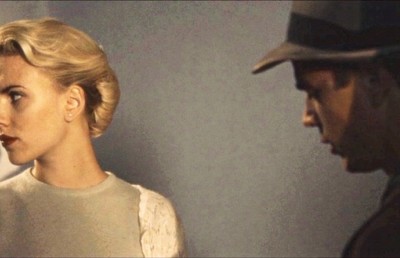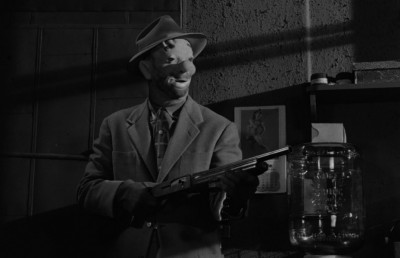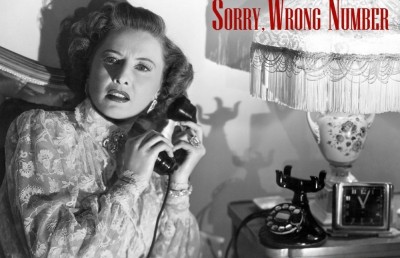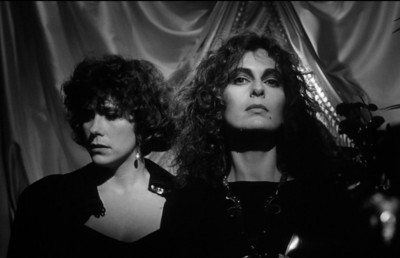Film Noir: A Study in Narrative Openings, Part 2
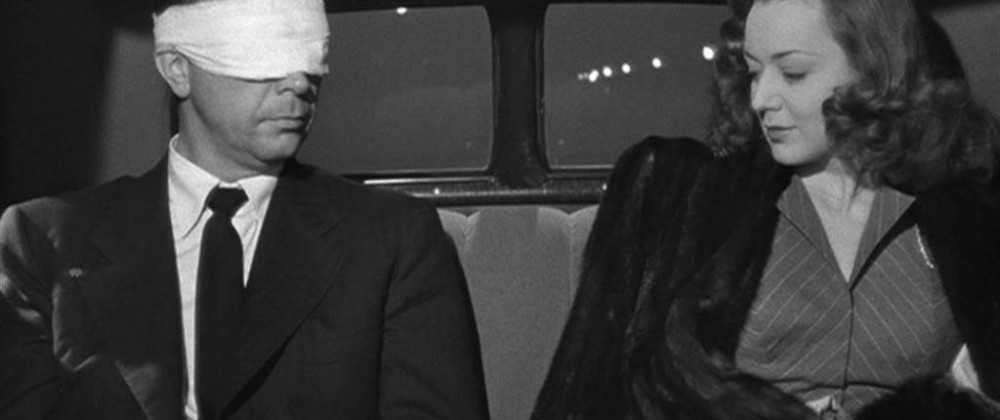
My goal in Part 2 is to expand on the number of case study films included in my analysis of film noir openings. For purposes of expediency and space, for the next series of films I have collapsed the distinction I used in Part 1 between “Description” and “Interpretation and Insights” into a briefer, less detailed analysis in which I will describe the openings in more general terms of action and event and highlight important points.
GROUP A1 (Framed Flashback)
Journey Into Fear (Norman Foster, 1942)
Length of Opening: 1’25”
The opening is a pre-credit sequence shot. The camera cranes up to a second story window and remains static while a large man is seen going through a series of actions: placing a record on a turntable, combing his hair, placing a gun in his suit pocket, putting on a hat and coat and leaving the room. After the titles we return to the large man walking along a dark street. This scene leads into the flashback. The flashback challenges the A B A structure because there aren’t any obvious visual cues, only Joseph Cotton’s voice-over narration.
Murder, My Sweet (Edward Dymtryk, 1944)
Length of Opening: 2’00”
The opening consists of an immediately established prologue (a police interrogation) leading to the bulk of the film, the flashback. The visual tone of extreme chiaroscuro is set in the opening, along with a major macro question: Why are Marlowe’s eyes bandaged (seen at extreme right of image below)?
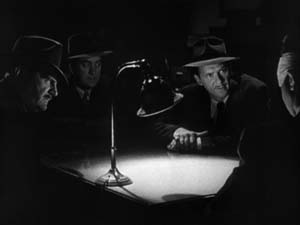
The Strange Love of Martha Ivers (Lewis Milestone, 1946)
Length of the Opening: 15’30”
The film begins in “Iverstown” circa 1928. The lengthy prologue introduces the principal characters as adolescents and establishes their personalities: Barbara Stanwyck (Martha Ivers)/vindictive and domineering, Kirk Douglas (Walter O’neil)/ meek and submissive, and Van Heflin (Sam Masterson)/tough and independent. Ivers murders her aunt. It becomes a shared secret by the three characters. (Although we later find out that Sam did not witness the murder.) The film flashforwards to 1946.
Body and Soul (Robert Rossen, 1947)
Length of the Opening: 10’45”
The film begins with an impressive opening shot. It is night. A deserted outdoor boxing ring is captured in high angle. The swaying punching bag, ropes, and corner poles cast dark shadows on the canvas. The camera cranes screen right past tree tops and down to the window of a house. John Garfield (Charlie Davis) is seen lying on a bed. Cut to a close up. He is talking in his sleep. He awakens from his disturbed sleeping yelling the name “Ben.” The remaining of the opening sets up a slew of boxing film conventions: the practice ring, the bar/cafe, the weigh in, the pre-game visit in the dressing room by the slickly dressed gambler, and the entourage (fans, manager, trainer, cut man). It primes us with two key macro questions: Who is Ben and how did he die? and Why is his relationship with his mother and wife so strained? The motivation is primarily narrational.
Body and Soul deviates slightly from the A B A flashback structure by repeating the opening shot of the film as a cue back to the present.
Criss Cross (Robert Siodmak, 1949)
Length of the Opening: 12’30”
This opening introduces the three principal characters: Steve (Burt Lancaster), an armored truck guard, Slim (Dan Duryea), an unsavory gambler/criminal and Anna (Yvonne De Carlo), Slim’s wife and Steve’s lover. Steve and Slim, apparent enemies, have planned a heist together. Anna has designs to run off with Steve after the heist, planned for the next evening. Like Body and Soul, this opening acts as a teaser, introducing the principal characters and priming us with micro & macro questions: If Steve and Slim are adversaries why have they planned a heist together? What are Anna’s real motives? As planned, Steve is driving the armored truck. Before arriving at the set up point Steve’s voice-over cues the flashback.
Champion (Mark Robson, 1949)
Length of the Opening: 3’00”
The action in this opening is identical to that of Body and Soul: the events leading up to the big fight. The difference is that this opening asks less micro/macro questions and does less priming. Unlike Body and Soul, the flashback is cued objectively by the words of the ringside announcer: “…the story of a boy who rose from the depths of poverty to become the champion of the world.” Also, once in the flashback we do not return to the present via a demarcated transition; instead the flashback arrives at the point where it began –the announcer’s words– and continues to the conclusion.
D.O.A. (Rudolph Maté, 1949)
Length of the Opening: 3’30”
The opening is partially a credit sequence. The camera tilts down to a long shot of a building. A man enters frame left, his back to us. Two dissolves later he is walking along the corridors of a police station. The camera remains behind him tracking to follow. He enters an office in the homicide division and reports a murder. When the detective asks him who was murdered we finally cut to his face. The close up is held for several seconds before he replies, “I was.” The transition to his flashback is made by a whirlpool like visual/sound dissolve.
Sunset Boulevard (Billy Wilder, 1950)
Length of the Opening: 2’40”
D.O.A. and Double Indemnity are narrated by dying men, one poisoned the other seriously wounded. Sunset Boulevard goes a step further by employing a dead narrator. The film begins with a brief credit sequence with the camera dollying back quickly along the pavement of a street, Sunset Boulevard. Once the credits are over William Holden’s (Joe Gillis) voice-over narration begins. While the visuals capture the police and newspaper people arriving at the scene of the crime the voice-over informs us of all the pertinent details: who the murder victim is (himself), who is involved, etc. The final shot before the flashback is from the bottom of the pool looking up at the floating corpse. This is what Edward Branigan would call an “impossible shot” (from the inside of a wall, mirror, fireplace, refrigerator, etc.) (p.62). However, considering the impossibility of a dead narrator, this POV seems justified and rather apt. Since a dead person’s optical POV would logically result in a black image I would call this an “out of body” POV.
GROUP A2 (Interspersed Flashbacks)
Laura (Otto Preminger, 1944)
Length of Opening: 5’39”
The film begins with the voice-over of Waldo Lydecker (Clifton Webb), narrating in flashback mode: “I will never forget the weekend Laura died. A silver sun burned through the sky like a huge magnifying glass. It was the hottest Sunday in my recollection. I felt as if I were the only human being left in New York…” As the voice-over continues the camera tracks smoothly, sensually, as if emoting the vacant female presence of Laura (Gene Tierney), along glass cabinets holding fancy objets d’arte, past a grandfather clock (which will become a key plot object, as it is used to store the murder weapon). The camera continues to pan right to frame in long shot, detective Mark McPherson (Dana Andrews), just as the voice-over informs us “…another of those detectives came to see me. I had him wait. I could watch him through the half open door.” In the same continuous shot, the camera pans left following McPherson as he walks over to the chiming grandfather clock. Lydecker informs us that there is only one other such clock in existence, and that it is in Laura’s apartment, “the very room where she was murdered.” This whole scenario –the grandfather clock, the murder weapon, and the murder, will repeat in the film’s final scene, which is a formal echo of this opening scene. The grandfather clock is an important plot point which foreshadows the link between the victim (Laura) and the murderer (Lydecker). Lydecker’s offscreen voice-over calls for McPherson, which brings a cut and an end to this long take of 1’35” as the scene cuts to inside Lydecker’s bedroom suite. The ‘past’ narration now gives way to present tense dialogue. The balance of the scene, a tête-à-tête between Lydecker and McPherson, plays out in a more conventional cutting style, but with the takes still considerably longer than average (15 ASL). However, this languorous mobile camera shot which opened the film sets the visual tone and style for much of the film. We are introduced to Lydecker through a swish pan (a symbolic gesture discussed below), which reveals Lydecker lying naked in the bathtub writing at his typewriter. At some point he asks McPherson to fetch his bathrobe, and as the camera pans right with McPherson we hear the sound of Lydecker exiting the bathtub, exposing himself to McPherson, a complete stranger. McPherson makes eye contact in his direction, letting the audience know that he has seen Lydecker nude. The eligible bachelor Lydecker is coded with all the usual Hollywood signifiers of homosexuality: his fastidious nature, wit, literate diction, fancily ardoned apartment, his well-groomed appearance, and profession as a writer/intellectual. Lydecker’s blatant exhibitionism sets up a sexual tension (in Lydecker’s case possibly homoerotic) which underscores all of the character dynamics (Laura/McPherson/Lydecker and Vincent Price’s slimey, Southern gigolo Shelby Carpenter, who is engaged to Laura but is being lusted over by Laura’s matronly sister, Mrs. Ann Treadwell, played by Judith Anderson).
The above mentioned swish pan which punctuates McPherson calling out “Lydecker,” is a reverberational device because it is used again as a connective device between Lydecker and the murder weapon in the film’s final scene. In the final scene Lydecker is revealed as the killer when he tries to kill Laura for a second time. (In an earlier plot reveal, the victim thought to have been Laura was a friend, Diane Redfern, who was wearing Laura’s negligee at the time she was shot in the face. The shot blast had disfigured her face beyond recognition.) Earlier in the scene Laura breaks off her long-standing relationship with Lydecker. The bruised Lydecker seemingly leaves the apartment, but in fact remains in the staircase unbeknownst to Laura. Laura prepares for bed by shutting off the living room lights and retiring to her bedroom. As she enters her bedroom the camera performs an identical swish pan to the one which introduced us to Lydecker in the opening scene, framing the grandfather clock and an adjoining door. Lydecker quietly enters the darkened room through the door and retrieves the rifle he knows is planted in the cavity of the grandfather clock. Laura is saved in the nick of time by police intervention. The film ends on a close-up of the gun-shattered grandfather clock.
Double Indemnity (Billy Wilder, 1944)
Length of Opening: 5’40”
An injured man, Fred MacMurray (Walter Neff), lumbers to an office building. He is knowingly greeted by the doorman. He takes the elevator to his office and begins to tape record a confession to a person named Keyes. The flashback is cued subjectively: “It all began last May.”
Mildred Pierce (Michael Curtiz, 1945)
Length of the Opening: 17’00”
As I stated in Part 1, it is tempting to consider the first scene in Mildred Pierce as the opening. In a sense it is the opening, since a completed action occurs, but the manner in which it fuses with the subsequent shot –maintaining a continuity in mood and time– makes it difficult to divorce. I will admit that it is, arguably, the most impressive scene in the film. The action is simple. A man is repeatedly shot by an off-screen person. He falls to the floor. Cut to a medium close-up He utters his final word, “Mildred.” The camera dollies across the corpse to a full length mirror. A door is heard slammed off-screen. Cut to a low angle long shot of the living room. It is beautifully lit in chiaroscuro. The light from the off screen fireplace causes irregular light/shadow patterns. The low angle and excessive depth of field makes the room appear endless. There is a cut to the car parked in front of the cottage driving off and a dissolve to a high angle shot of the rain soaked boardwalk.
A macro question is set out for the viewer: Who killed the man? As well as a micro question: Who was the man? From the rest of the opening we are encouraged to (incorrectly) infer that Mildred (Joan Crawford) is the killer.
The opening’s expressionistic flavor will persist throughout the film. There is a specific recurring lighting pattern for Mildred. She is often photographed with a shadow cast across either the left or right side of her face. At times it appears unnatural, as other characters and objects within the shot are free of shadows. The first scene is reminiscent of Citizen Kane (a man’s dying word), The Letter, and a film made one year later, The Dark Mirror.
Out of the Past (Jacques Tourneur, 1947)
Length of the Opening: 11’00”
Out of the Past is similar in tone and theme to the beginning of Siodmak’s The Killers. We can assuredly infer that the tall, darkly dressed stranger who drives into the small town asking for Jeff Bailey (Robert Mitchum) signals a dark past. He stops at Jeff’s gas station then enters a nearby cafe to inquire about his whereabouts. Jeff is fishing with his girlfriend. The deaf and mute gas station attendant goes to call him. Jeff’s character is diegetically cued by his girlfriend (“You sure are a secret man”) and the waitress in the cafe (“….the mysterious Jeff Bailey”). He is the archetypal noir protagonist, striving to remain one step ahead of his past. He finds temporary refuge in a small town. (Several film noirs employ the rural milieu as a symbol for unattainable freedom.) Here we have the classic noir theme of the hunter and the hunted (The Killers, The Stranger, Cornered, They Live by Night, Nicholas Ray, 1948, The Asphalt Jungle). Like many noir protagonists, Jeff Bailey is tired and unwilling to run anymore. He has accepted his fate.
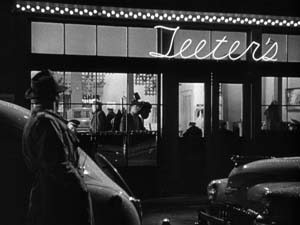
The opening does not reveal any expositional information other than names from the past. Although its driving force is partly narrational, priming us for the flashback, it is also reverberational because the priming is of mood and ambience rather than actual story information. The flashback is the reverse, overloading us with narrative information.
Knock On Any Door (Nicholas Ray, 1949)
Length of the Opening: 1’50”
The opening scene is a fast paced shootout in a city slum district. A police officer is shot dead by an anonymous criminal. A major macro question is animated: Who shot the policeman? In the next scene the question is re-addressed: Did Nick Romano (John Derek) kill the policeman? More importantly is the establishing of the poverty milieu, which will lead to some heavy handed social commentary.
GROUP B1 (Linear)
High Sierra (Raoul Walsh, 1941)
Length of the Opening: 2’00”
High Sierra begins with a montage in the classical Hollywood/Warner Bros. tradition, elliptically and economically compressing the opening action: Roy Earle’s (Humphrey Bogart) release from prison. The first thing Roy Earle does is go to a park to make sure that the “grass is still green and trees are still growing.” The brief scene in the park primes us for the central theme of the film: the equation of nature with freedom (“crashing out”). The opening also indicates the (rather uncommon to the film noir) high key visual style and linear micro question structure of the film.
The Maltese Falcon (John Huston, 1941)
Length of the Opening: 4’45”
The space is established gradually by a series of dissolves from an intertitle reading “San Francisco” to shots of the city skyline, the Golden Gate bridge, and the Spade & Archer sign on the window. The opening ends on the reflection of the Spade & Archer logo on the office floor. During the opening we are introduced to three principal characters, Effie (Lee Patrick), Brigid O’Shaughnessy, alias Miss Wonderly (Mary Astor), and Sam Spade (Humphrey Bogart) and one (retrospectively) minor character, Miles Archer (Jerome Cowan). The opening sets the micro question structure of the film in motion. Its motivation is strictly narrational.
The Glass Key (Stuart Heisler, 1942)
Length of the Opening: 1’45”
This is an unexceptional opening which functions narrationally. It introduces the three principal characters, Paul Madvig (Brian Donlevy), Janet Henry (Veronica Lake), and Ed Beaumont (Alan Ladd), the political context, and the questionable ethics of those involved.
Cornered (Edward Dymtryk, 1945)
Length of the Opening: 13’30”
A Canadian veteran, Gerard (Dick Powell), is released from a war camp and returns to France to investigate the death of his young war bride. He discovers that she was executed, along with other French citizens, by a man named Marcel Jarnac, who is officially dead but believed by many to be alive. The opening concludes at the moment (a dissolve) when Gerard begins his long search for Jarnac.
The opening establishes the theme of obsessive (male) vengeance. From certain clues we can infer that Gerard is mentally unstable and still suffering from war trauma. Gerard experiences a mild attack when his father in law, Perchon, recounts the fatal incident. The camera dollies in to a close-up of Gerard. He is sweating and shaking slightly; we hear gunshots and Gerard’s voice echoing his wife’s name. He snaps out of the mild attack in an angered state and orders Perchon to tell him who ordered the killings. Perchon tries to calm him down and says, “You have just left the hospital, perhaps too quickly.” These clues prime us for the final scene in the film, when Gerard finds Jarnac and uncontrollably beats him to death. The film presents one of the starkest portrayals of the sort of vigilante male violence and aggression common to the film noir.
Scarlet Street (Fritz Lang, 1945)
Length of the Opening: 4’30”
The first two shots of the film are of rain soaked studio streets, establishing the dark, Germanic look which will characterize the film. Cut to an office party celebrating the 25th anniversary of a bank clerk, Christopher Cross (Edward G. Robinson). Like Notorious and D.O.A., our first introductions to the lead character Cross are from behind, stressing his anonymity and pointing toward the film’s theme of dangerous chance encounter. The boss has to leave early. The men huddle around the window to spy on the elderly man entering his limousine with a younger woman. The men profess their envy and lament their old age. This foreshadows Cross’ imminent fateful chance encounter with the young Kitty March (Joan Bennett).
Gilda (Charles Vidor, 1946)
Length of the Opening: 2’45”
The opening takes place on the docks and is established immediately with a tilt up from below the pier to reveal a gambling game in progress. Johnny Farrell’s (Glen Ford) voice-over narration informs us that, knowing American soldiers, he better not press his good fortunes. While counting his winnings he is threatened by a thug. Farrell is aided by a well dressed stranger (Ballin Mundson, played by George Macready) wielding a lethal cane. The ensuing dialogue between them primes us for a bizarre, pathological, and homoerotic relationship:
Farrell: Cane like that could come in handy.
Ballin: It is a most faithful and obedient friend. It is silent when I wish it to be silent and it talks when I wish it to talk.
Farrell: That’s your idea of a friend?
Ballin: That is my idea of a friend.
Farrell: You must lead a gay life?
Although the word ‘gay’s was not yet coded in the 1940s, this dialogue is still just a hint of what is to come. In fact I do not believe there is another noir screenplay which matches Gilda for sexual innuendo and sheer maliciousness.
The Stranger (Orson Welles, 1946)
Length of the Opening: 0’45”
The action is simple: a group of allied war commissioners discuss whether or not to release a minor Nazi criminal in the hope that he will lead them to a higher Nazi criminal. Wilson (Edward G. Robinson) is adamant and demonstrative of his feelings, “…let him escape … it’s our only chance … this obscenity must be destroyed, you hear me, destroyed,” as he slams his pipe down against the table. There is a fade out. In the immediate scene we see the Nazi criminal boarding a train; the micro question has been visually answered.
Wilson’s conduct in the opening primes us for his dogged determination. Stylistically, the use of low and high angles, moving camera, and low key lighting set the tone for the film. It is a revelatory opening.
The Big Sleep (Howard Hawks, 1946)
Length of the Opening: 8’00”
Like The Maltese Falcon, this opening introduces the major characters, Philip Marlowe (Humphrey Bogart), General Sternwood (Charles Waldron) and his daughters Carmen (Martha Vickers) and Vivien (Lauren Bacall) in an expositional opening which, to use Hitchcock’s term, serves as a McGuffin. Both films begin with a private detective gathering information from a client. In this case he is to solve a blackmailing scheme.
The space is established immediately, a close up of the Sternwood name plaque on the door and a quick pan to a finger on the doorbell, compared to the gradual style in two other Warner Bros. films, The Maltese Falcon and High Sierra. The story information rendered is not as important as the style and characterization. The style is classic Hawks, no frills attached and subservient to the story. The opening establishes the repartee which is to dominate the film and the schemata in which it is rendered. Marlowe becomes engaged in snappy one on one dialogue with four characters: Carmen, General Sternwood, Vivien, and the butler. The schemata employed –conventional shot counter shot between two people– will prevail throughout the film as the mode of narrative exposition. Hawks’ classical approach to form –the use of shot counter shot, normal (straight on) camera angles, high key lighting in the majority of scenes, etc.– is evidence that not all film noir employ the expressive visual style (chiaroscuro lighting, canted angles) often identified by critics and historians as the standard for film noir.
The Lady From Shanghai (Orson Welles, 1947)
Length of the Opening: 6’20”
Three dissolves (bridge, city skyline) bring us to a shot of a horse and carriage trotting along a quiet park road. A lovely blond woman Elsa Bannister (Rita Hayworth) is seated alone in the back seat of the carriage. Cut to a medium close-up of Michael O’hara (Orson Welles) walking alongside the carriage. An exchange ensues between two strangers obviously attracted to each other physically. This opening is primarily narrational, priming us for an illicit affair between the beautiful femme fatale Elsa Bannister and the roguish Irish sailor, O’hara. Although the narrative is linear, O’hara’s subjective voice-over punctuates the film and sets it in the past; as he says moments before rescuing Elsa from a group of amateur thugs, “And that’s maybe the reason why I start out in this story a little bit like a hero, which I most certainly am not.”
Welles penchant for the long take and moving camera is evidenced in the initial dialogue scene. Elsa is seated in the carriage and Michael atop it. The camera tilts up and down rather than cutting from one to the other.
Key Largo (John Huston, 1948)
Length of the Opening: 1’15”
This unexceptional opening does little more than add an exterior scene to a film which takes place almost exclusively in a hotel. (It is based on a play.) It begins with an aerial shot of a car trailing a bus along a highway. Cut to the car pulling the bus over. An officer informs the driver that two Native American Indians have escaped from prison. The Native American Indians will resurface later in a minor way. Frank McCloud (Humphrey Bogart) is one of the passengers. A series of dissolves later, the bus arrives at the hotel, Frank McCloud disembarks and the film proper begins.
Caught (Max Ophuls, 1949)
Length of the Opening: 3’45”
This opening is a perfect example of how the immediate establishing shot can be used for effect, in this case deception. It begins on a close-up of a fashion magazine. We see hands pointing to items and turning pages and hear the adjoining voices commenting on the items. The impression is that we are in a high class department store. Seconds later the camera pulls back and establishes the space: a small, modestly furnished apartment, shared by two women. This schemata of introducing a space (from a tight close-up to a pull back that establishes location) is used often by Max Ophuls.
The scene introduces the major character Leona (Barbara Bel Geddes), her predicament (poor), and her plans to enroll in “Dorothy Dale’s School of Charm” in the hope of meeting a young, handsome millionaire. The scene foreshadows her eventual encounter with such a man.
There are only four cuts in this opening. That works out to an exceedingly long ASL of 56 seconds. Although the ASL for the entire film is much faster (around 17 seconds) it does prime us for Ophuls’ mise en scène style (a dependence on crane/track/dolly shots, lateral movements, elaborate blocking, and the “4th wall” shot). [1]
GROUP B2 (Linear/Powerfully Emphatic)
The Spiral Staircase (Robert Siodmak, 1945)
Length of the Opening: 4’30”
A L-R tracking shot along a late 19th century road leads us to a theatre house. Cut to the interior. The audience is enjoying the 1896 silent film The Kiss. Among the spectators is Helen (Dorothy McGuire). The camera tilts up from a shot of Helen to the ceiling then dissolves to a woman in the upstairs room. This is an important camera movement not only because it connects the adjoining spaces but symbolically links the two disabled women (mute/limp), pointing toward the perverse motive for the murders.
The highlight of the film is the stylized, perhaps bordering on sensationalistic, murder. Compared to the excessiveness of current cinema this murder is an exercise in restraint, employing extreme subjectivism, synecdoche (a part filling in for the whole), and timely cutting rather than visceral on screen violence. A woman walks (with a noticeable limp) to the closet and selects a dress. She leaves frame right and the camera dollies in to the clothes; there is a rustle. Dissolve to an extreme close-up of an eye and then a zoom in to the pupil. Through the pupil we see the reflection of the woman changing. She hoists the dress up over her head. Cut to a medium close-up of her arms drawing the sleeves down. At a certain point in the shot her hands begin to move spasmodically. The killer has attacked. A moment before her hands come to a stop there is a cut to the movie screen downstairs. The film is over and “The End” appears. The murder, although sensational, does function narrationally because it sets in motion two central macro questions: Who is the murderer? and What is the motive?
Notorious (Alfred Hitchcock, 1946)
Length of the Opening: 3’10”
The camera pans L-R past several reporters and photographers to the lettering above a door: United States District Court. The people are awaiting the verdict to an important case. This scene functions narrationally, telling us that a man, Alicia Huberman’s (Ingrid Bergman) father, has been convicted of treason, but it also hints at a major theme of the film (and all of Hitchcock’s oeuvre): voyeurism. After the initial shot there is a cut to a man slyly opening the door to the courtroom followed by a match cut on the door opening to his optical POV: eavesdropping. The theme is presented in striking terms in the succeeding scene. For this reason I consider these two scenes, disparate in action but common in theme, as the “opening.”
The next scene is handled in one shot. After a dissolve the camera dollies in and pans to the right to capture a dark, silhouetted figure seated with his back to the camera in the extreme foreground and a group of people facing us (and him) in the middle ground, dancing and drinking. The dark, chiseled figure (Cary Grant) reminds us of the act of film viewing. At certain points in the framing he is in the lower left corner of the frame, as if he were a spectator in the first row of the theatre. From his silence, inaction, and visual separation from the rest of the image we can infer that Hitchcock is commenting on the voyeuristic and scopophilic nature of film. This foreshadows the film’s central theme of emotional voyeurism and deception: Alicia feigns love for Alexander (Claude Rains) in order to gain his confidence in marriage and help break a Nazi espionage ring.

The Dark Mirror (Robert Siodmak, 1946)
Length of the Opening: 1’00”
The opening is a stylish and intricate sequence shot. The image begins on a city skyline at night. The camera dollies left to right past the curtains to a clock on a desk; it stops momentarily then dollies back and L-R to an open door. Visible in the background is an upturned lamp lying on the floor. The camera dollies into the room over the lamp and toward a shattered mirror (a visual symbol for the good/evil twin sisters) hanging above a fireplace. The camera continues its L-R movement downward across a sofa and finally to a corpse, knife in back, lying on the floor.
This is one of the film’s most impressive scenes. The intricate camera style is never repeated, as the film relies more on emphatic editing and less mobile (sometimes static) long takes. Although the opening is reminiscent of Mildred Pierce it is dissimilar in its relationship to the rest of the film. In Mildred Pierce the opening fuses with the film, while in The Dark Mirror it has the feeling of a disengaged prologue. Outside of this opening the rest of The Dark Mirror is closer to melodrama than film noir.
This opening brought to mind an insight made by Wolfenstein & Leites in their book Movies: A Psychological Study. In the chapter “Killers and Victims” (p.178) they discuss how in the cinema of the 1940’s the victim is often objectified and the murder made to function solely as either the starting point for furious activity (The Letter, The Maltese Falcon, Mildred Pierce, The Dark Mirror, The Spiral Staircase, Knock On Any Door, and, to a lesser extend, Double Indemnity, D.O.A., and Sunset Boulevard) or the end of such activity (This Gun For Hire, Cornered, Gilda, The Stranger, Out of the Past, Sorry, Wrong Number, and White Heat). Also, there is little sympathy or attachment to death because they either get what they deserve or, if not, the death is seen as a form of freedom or salvation (High Sierra, Out of the Past, Criss Cross, The Strange Love of Martha Ivers, Champion, White Heat, The Asphalt Jungle).
The Asphalt Jungle (John Huston, 1950)
Length of the Opening: 2’15”
The first ten shots of The Asphalt Jungle constitute an opening which is motivated entirely reverberationally. The little narrational information given –a stranger is arrested by the police– is subservient to a visual mosaic which establishes the tone, mood, and thematic undercurrents of the film. On a story level the detraction of this opening would not impair an understanding of the plot. With it we are immediately engulfed into a noir world as oppressive and foreboding as any.
Dark and overcast, the time is indiscernible, it could be dawn or dusk. A black police car prowls the deserted neighborhood, its radio cutting through the silence. A tall, dark stranger slips in and out of the enclosing architecture, remaining unseen, a man forever running from the ghosts of his past. The third shot in the sequence is especially indicative of the imprisonment: the man framed in extreme long shot hiding behind a pillar of an empty arched passageway.

In the fifth shot he walks up along a slanted narrow road, totally engulfed by the tall buildings. In the next shot he enters frame left and walks toward a dingy corner cafe. He enters the cafe and seconds later the police enter and arrest him. Three elements have been introduced: prey, predator, and ‘urban’ jungle.
Two major themes of the film are visually primed: the claustrophobic noir world and the noir fugitive trapped within it. The self enclosing, dominating architecture and sinister mood imprison the noir fugitive. He seeks temporary refuge in a café run by a friend who stashes his gun for him, knowing that it is only a matter of time. Claustrophobia in the noir world is total, existing in vast space and confined areas. It is rendered in this mainly exterior opening through the juxtaposition of the human figure (Sterling Hayden), in long shot, against the overwhelming surrounding. For the rest of the film, mainly interiors, Huston achieves a claustrophobic feeling through the use of tight compositions, low key lighting, and low angles. The means are different but the result is the same.
The opening is paradigmatic of the film as a whole: pursuit, temporary refuge, and inevitable seizure, a beginning, middle, and end. In the film a group of criminals plan one last major heist. After the heist they are again thrust into the role of prey. They are all eventually caught or killed. Like in the opening, regardless of how much they run, their fates are signed, sealed, and delivered.
Final Thoughts
In conclusion, although there are many repeating formal and thematic gestures one can outline across these film noir openings, one thing this analysis bears out is that the emphatic openings discussed are as varied in style as the films themselves. Since the films are part of the Hollywood classical period the openings must, at least in part, be motivated narrationally. They must immediately render some story exposition to animate the film. However, film noir is also characterized by reverberational motivation. The elements being echoed and foreshadowed include tone/mood, style, theme, and important psychological character traits. The extent to how emphatic and expressive an opening is depends heavily on the balance between the two motivational factors. In certain cases the openings are mainly narrational (The Maltese Falcon, The Glass Key, Key Largo); in some cases the two are balanced (The Dark Past, Sorry, Wrong Number, D.O.A., The Stranger) while at times reverberational motivation dominates (The Letter, Notorious, The Set-Up, The Asphalt Jungle). The films from Group B2, where reverberational motivation normally dominates, belong on the most extreme side of the classical style’s bound alternatives. Close analysis revealed, however, that even the more classical narrationally motivated noir opening can contain undercurrents over and above strict story exposition.
What are some of the more common schemata employed in the openings? In the majority of cases the schemata employed seemed ideally suited to the demands of the narrative, theme, and mood. For example, Sorry, Wrong Number and The Asphalt Jungle employ antithetical schemata. In the former a Bazinian respect of space is maintained by a predominance of the moving camera and long take. In the latter the editing both fragments and unifies the space. Despite the difference in style the respective schemata blend so well with the subject that the openings can not be conceived of in any other way. Leona’s isolation is agonizingly captured by the fluid camera movements, while the oppressive mood in The Asphalt Jungle is aptly rendered by the tableau like selection of essentially static shots. It is a perfect marriage of form and content. The same can be said for The Set-Up and The Spiral Staircase. In The Set-Up the calculated pans and reframes join together and contain the characters within the noir boxing world. In The Spiral Staircase the editing maintains a balance between taste and sensationalism, cutting away to a shot of a movie’s end title to stand in for the off-screen death of the woman.
In other cases narrational motivation gives way to artistic motivation . The most obvious example is Caught. The long takes and pointed camera movements (i.e. the ‘4th wall’ shots) here do not have the same resonance of those in Sorry, Wrong Number. Which is not to say that they do not have aesthetic appeal, but that they can be traced to Ophuls rather than any specific demands of the narrative. The same directorial stamp is evident in Welles’ films. Schemata are motivated by several factors: generic (past works), narrational (subject & story demands), and artistic (directorial vision/style).
For a film noir to be effective it is not necessary that extreme expressionism or stylization be employed. Films like This Gun For Hire, The Maltese Falcon, White Heat, The Big Sleep, High Sierra, and Key Largo are all films which, for the most part, conform to the dominant Hollywood “invisible style” or, to use Noël Burch’s term, the “zero point of cinematic style” (p. xix), i.e. 180 degree rule, eye line matches, shot reverse shots, match cuts, unobtrusive camera movements, naturalistic lighting, linear narrative structure, etc. Film noir’s latitude is such that it also allows the more expressionistically inclined to thrive (Welles, Litvak, Hitchcock, Lang, Siodmak, Wilder). A later noir phase would incorporate a more realistic strain, making film noir one of the only concerted group of films to exhibit touches of classicism, expressionism, and a semi-documentary realism. As a style film noir can be defined by the contradictory term, “realistic expressionism.” It is no wonder that the film noir period was one of the most aesthetically prosperous and fruitful in the history of American cinema.
Endnotes
1 The 4th wall is a theatrical term referring to the imaginary side of the room facing the audience which has been removed in order to create an opening onto the stage world. I have adapted this term to define a moving camera shot, usually lateral, which tracks along the ‘4h wall” of a set and exposes its artificiality. An example is the lateral tracking shot from one room to another which reveals the “split” wall adjoining the two rooms.
Works Cited
Bordwell, David. Narration in the Fiction Film. Madison, Wisconsin: The University of Wisconsin Press, 1985.
Bordwell, David, Janet Staiger, and Kristin Thompson. The Classical Hollywood Cinema. New York: Columbia University Press, 1985.
Branigan, Edward. Point of View in the Cinema: A Theory of Narration and Subjectivity in Classical Film. New York: Mouton Publishers, 1984.
Burch, Noël. Theory of Film Practice. Translated by Helen R. Lane. New York: Praeger Publishers, 1973.
Carroll, Nöel, “Film History and Film Theory: An Outline for an Institutional Theory of Film.” Film Reader 4, 1979, pp. 81 96.
Carroll, Nöel. “The Power of Movies.” Daedalus, Fall, 1985, pp. 79 103.
McArthur, Colin. Underworld USA. London: Secker & Warburg, 1972.
Naremore, James. “American Film Noir: The History of an Idea.” Film Quarterly. 42/2 (Winter 1995-96): 12-28.
Perkins, V.F. Film as Film. Middlesex, England: Penguin Books, 1976.
Place, J.A. & L.S. Peterson. “Some Visual Motifs of Film Noir, ed. Bill Nichols. Movies and Methods. Berkeley, Los Angeles: University of California Press, 1976, p. 325-338.
Schatz, Tom. Hollywood Genres: Formulas, Filmmaking, and the Studio System. Philadelphia: Temple University Press, 1981
Schrader, Paul. “Notes on Film Noir.” Film Comment 8, no.1 (1972), pp. 8 13.
Shadoian, Jack. Dreams and Dead Ends: The American Gangster/Crime Film. London: MIT Press, 1977.
Marc Vernet, “The Filmic Transaction: On the Openings of Film Noirs.” The Velvet Light Trap. No. 20 (Summer 1983): 2-9.
Wolfenstein, Martha and Nathan Leites. Movies: A Psychological Study. New York: Atheneum, 1970 (2nd ed.).
Works Consulted
Carroll, Noel. “Toward a Theory of Film Editing.” Millennium Film Journal no.3 (1978), pp. 79 99.
Gombrich, E.H. Art and Illusion: A Study in the Psychology of Pictorial Representation. London: Phaidon, 1977 (5th ed.).
Gombrich, E.H. The Image and The Eye: Further Studies in the Psychology of Pictorial Representation. Oxford: Phaidon, 1982.
Gregory, R.L., and E.H. Gombrich, eds. Illusion in Nature and Art. London: Duckworth, 1973.
Henry Jenkins, “Fifi Was My Mother’s Name! Anarchistic Comedy, the Vaudeville Aesthetic, and Diplomaniacs” in Velvet Light Trap No. 26, Fall 1990, 3-27
Salt, Barry. Film Style and Technology: History and Analysis. London: Starwood, 1983.
Silver, Alain and Elizabeth Ward. Film Noir: An Encyclopedic Reference to the American Style. Woodstock, New York: The Overlook Press, 1979.



